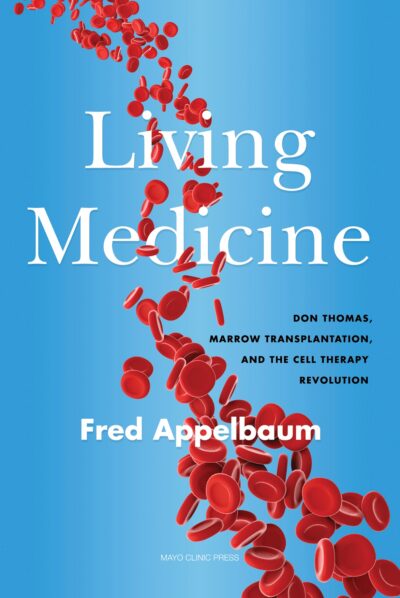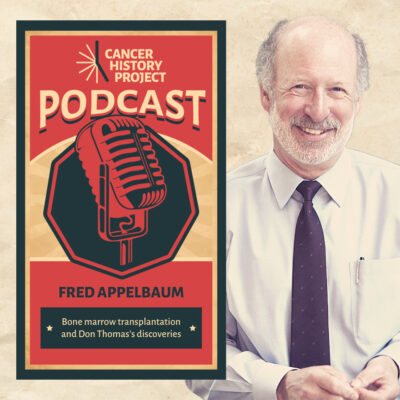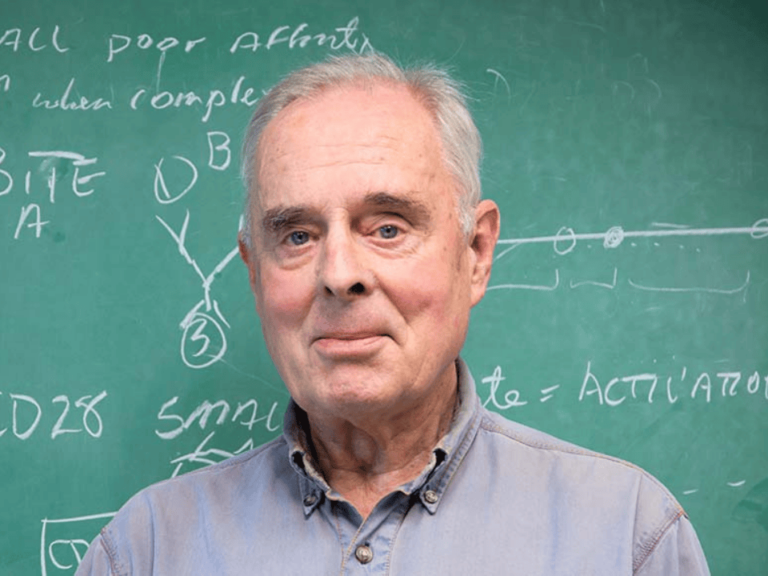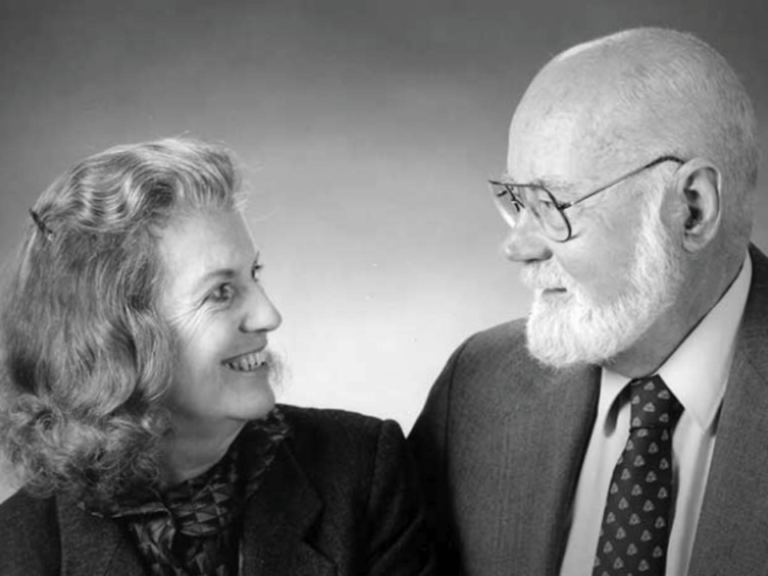

Frederick Appelbaum, executive vice president, professor in the Clinical Research Division, and Metcalfe Family/Frederick Appelbaum Endowed Chair in Cancer Research at Fred Hutchinson Cancer Center, is the author of “Living Medicine: Don Thomas, Marrow Transplantation, and the Cell Therapy Revolution.”
Appelbaum spoke with Alexandria Carolan, associate editor with the Cancer History Project, about the book and the importance of documenting the history of bone marrow transplantation.
A book review of “Living Medicine” appears here.
- Fred Appelbaum’s “Living Medicine” tells the gripping story of the genesis of bone marrow transplantation and Don Thomas’s Nobel-prize-winning discoveries
By Cancer History Project | May 19, 2023
“Living Medicine: Don Thomas, Marrow Transplantation, and the Cell Therapy Revolution” | By Frederick Appelbaum, MD | Mayo Clinic Press | $27.99
In 1970, in the journal Blood, a second-year medical student named Frederick Appelbaum read a paper describing a 46-year-old man with blastic crisis of chronic myelogenous leukemia who was given 950 rads whole-body irradiation followed immediately by 17.6 x 109 marrow cells.
To rescue this patient from this lethal dose, the study’s senior author—E. Donnall Thomas—injected marrow cells from the patient’s sister into the patient, and the cells successfully grafted.
The concept, blood marrow transplantation, was considered new, strange, and imperfect. Appelbaum, then a student at Tufts, felt the unmistakable recognition of his own path in the world.
“Why does somebody love classical music or someone love poetry? There are things that just appeal to us,” said Appelbaum, executive vice president, professor in the Clinical Research Division, and Metcalfe Family/Frederick Appelbaum Endowed Chair in Cancer Research at Fred Hutchinson Cancer Center. “[Bone marrow transplantation] hadn’t been worked out in humans yet. But the idea that you could get rid of someone’s entire hematopoietic system and transplant a normal one in place of it just seemed extraordinary.
“From then on, don’t ask me why, it was like having my brain tattooed. I just couldn’t get it out of my mind,” he said.
Delving deep into Thomas’s role in discovering bone marrow transplantation and its role in curing hematologic cancers, Appelbaum, who became Thomas’s mentee and collaborator, wrote “Living Medicine: Don Thomas, Marrow Transplantation, and the Cell Therapy Revolution.”
“If it hadn’t been told, and if the story had been lost to history, I just thought that would be a tragedy,” Appelbaum said to The Cancer Letter. “We’ve gone from a setting where Don and just one or two other people were the only ones that thought marrow transplantation was even possible in the 1950s, to today, where there are 100,000 transplants performed worldwide every year and 40 million people have signed up and registered to be potential stem cell donors.”
In the 1950s, Thomas, a hematology fellow at Harvard, witnessed Sidney Farber use aminopterin to achieve short-term complete remissions in children with leukemia.
“Don was very drawn by that,” Appelbaum said. “He then read about the spleen shielding experiments that were going on by Leon Jacobson, and suggested to Don that marrow transplantation might be possible.”
Farber, then Thomas’s boss, became more conservative in treating patients after the first string of successes, and was unwilling to try combination therapy.
When Thomas approached him with the idea of conducting experiments in blood marrow transplantation, “Farber thought it was a terrible idea and wouldn’t give him any space,” Appelbaum said. “That was when he decided that he would prefer to pursue the idea than to stay at Harvard, and that’s when he moved to Cooperstown.”
At Imogene Bassett Hospital, Thomas teamed up with Joe Ferrebee, who was also interested in the potential bone marrow transplantation might have to cure hematologic diseases.
“In 1956, they did their first human transplants, which failed very quickly in six patients that were reported in the New England Journal of Medicine,” Appelbaum said. “There was perhaps short-term engraftment in one of the patients, but only really temporary and very minor. It certainly was a failure by any stretch of imagination.”
Realizing that an animal model was necessary, Thomas began conducting research in canines, an outbred species more similar to humans than mice. In 1957, Thomas and Ferrebee presented their findings at an annual meeting of the “Blood Club,” a precursor to the American Society of Hematology, in Atlantic City.
“There were different people presenting the little work that they had done in animal model,” Appelbaum said. “That was the first time that Don and Joe Ferrebee presented their information. They had actually tried this in humans, and there was a lot of pushback saying, “We’re not ready to do that—and please don’t do that, that there just isn’t enough knowledge to think that it would have much of a chance of success.’”
Criticism like this would continue throughout much of Thomas’s career.
“That’s a tension that happens all the time,” Appelbaum said. “There are people who want to push the envelope a little bit more, and other people who are more conservative about it. Certainly, today, there are different regulations that didn’t exist at the time that Don was doing this work. You could argue—is that good or bad? I’ll just say it’s different.”
In another breakthrough, in 1960, Thomas treated an aplastic anemia patient with marrow from her identical twin. She recovered within two weeks.
“That’s the first person on the face of the earth who was ever cured with a marrow transplant,” Appelbaum said.
“They still are doing well. That was the first insight that he definitely could transplant bone marrow. Though it was only in identical twins—at least he knew that for sure you could transplant bone marrow.”
In the early 1970s, HLA typing evolved to the point where it was possible to choose an HLA-compatible donor from among siblings.
“That allowed Don to make the leap from just this rare, identical twin setting to the more relevant setting of brothers and sisters who are HLA-identical in the very first transplants that were done that allowed for cure of leukemia in 1971,” he said. “Those were the two big things: You could do transplants in twins, and you could overcome the histocompatibility barrier by selecting donors and recipients who are HLA matched.”
Appelbaum recalls a talk Thomas gave at the 1975 annual meeting of the American Association for Cancer Research.
“I was blown away that you could take patients who had end-stage leukemia, and transplant them, and cure some of them,” Appelbaum said. “Now, the problem was that you were only curing, at the end of the day, between 12 and 14% of the patients, and many of the others—you probably were hastening their death because there was a lot of toxicity from the transplants. People were dying from mucositis, from infections, from CMV infections. There were lots of problems.”
The patients, who had end-stage leukemia, would die in another month if they weren’t treated.
“If you have someone who has an end stage disease, is it better to do nothing and let the disease take its course? Or is it better to try something, understanding that you may be causing a lot of toxicity, pain, and anguish, and the chances of success are small?” Appelbaum said. “I don’t have the right answer to this. I mean, I don’t know that anyone does, but I think that people that get to make the choice should be the patients more than anyone else.
Appelbaum received a call from Thomas in 1977 asking whether he would be willing to work with him.
“It was like the heavens opened up and God was looking down at me and saying, ‘Would you like to come?’ It was really quite an honor to be noticed and to be able to work with him from the beginning,” Appelbaum said.
At Fred Hutch, Thomas created a team to treat patients with bone marrow transplantation and develop supportive care.
“He was taking in people that were focused on infectious diseases in the transplant patient, in GI complications in the transplant patient, pulmonary problems in the transplant patient,” Appelbaum said. “He had his own dieticians, his own social workers, his own pharmacists. It really took—it’s a cliche now, but it did take a village to solve the problem.
“If you asked me what was unique about Don, it was his focus, his persistence, his ability to draw a team, to solve a very difficult problem.”
The team at Fred Hutch helped develop supportive care measures to address the major complications of marrow transplantation in the early days of transplantations. Then, patients would develop bacterial, fungal, and viral infections. They developed mucositis that could cause them to starve to death. Socially, the lives of patients were disrupted when they moved to Seattle for treatment.
“Don created his own ward because he didn’t trust the care that patients would get anywhere else,” Appelbaum said. “Key to that ward were the nurses. Don often referred to the nurses as a secret weapon. They were incredible, I mean—it takes a certain kind of nurse to be able to work with incredibly ill patients, knowing early on, that seven or eight out of 10 were going to die. But, to give them the very best care they could, as long as they could, with the hope that there would be survivors.”
Thomas was responsible for recruiting teams of people to focus on supportive care issues. They used laminar airflow rooms to prevent infections. He recruited Bob Hickman from Seattle Children’s Hospital, who developed an indwelling catheter that could give infusions and hyperalimentation—patients were no longer starving. Finally, social workers helped patients adjust socially.
“It was infections, it was nutrition, blood support, nursing, social work. It was everything,” Appelbaum said.
Bone marrow transplantation can cure virtually every marrow-based disease, Appelbaum said.
“The implications of what Don did are not just development of marrow transplantation, which is huge in and of itself, but the implications are really changing the face of medicine, which is why, in the book, I talk about the fact that this is not just about marrow transplantation—it’s also about this revolution in cell therapy,” he said.
Appelbaum spoke with Alexandria Carolan, associate editor with the Cancer History Project. The transcript and a podcast recording of this conversation are available on the Cancer History Project.
Excerpt from Fred Appelbaum’s “Living Medicine,” the story of Don Thomas


- Excerpt of “Living Medicine: Don Thomas, Marrow Transplantation, and the Cell Therapy Revolution.”
By Cancer History Project | May 18, 2023
The following excerpt is from “Living Medicine: Don Thomas, Marrow Transplantation, and the Cell Therapy Revolution,” by Fred Appelbaum, MD, Metcalfe Family Professor at the Fred Hutchinson Cancer Center.
Late in the summer of 1960, Dr. Clem Finch invited Dr. Don Thomas to Seattle to give a talk about his early experience with transplantation. Clem, who had been Thomas’s hematology fellowship instructor at the Brigham in Boston, had since moved to Seattle to join the faculty of the new University of Washington School of Medicine. During his lecture in Seattle, Thomas acknowledged his frustration that he had yet to show that marrow transplantation could cure anyone—either there had been problems with graft rejection and graft-versus-host disease, or the leukemia recurred.
After the lecture, a young physician came rushing up to the podium. “We have the ideal patient!” Moreno Robins remembered saying more than 50 years later. Robins was a pediatrician completing his internship at the University of Washington and was caring for a six-year-old girl, Nancy Lowry. Nancy had been well until a few months before, when something changed. She became pale, her gums began to bleed, bruises spontaneously formed over her arms and legs, and she developed intermittent fevers. Examination of her blood showed a paucity of white cells, red cells, and platelets, and a bone marrow examination was markedly abnormal, being largely devoid of cells and replaced by fat. Nancy had aplastic anemia. She also had an identical twin.
Aplastic anemia, first described by Paul Ehrlich in 1888, is a terrifying and mysterious disease in which the marrow suddenly stops working. With no red cells, platelets, or white cells being produced, the patient quickly becomes profoundly pale and anemic, susceptible to bleeding, and at risk for the development of overwhelming infections. Even today, aplastic anemia is imperfectly understood. Most scientists think that exposure to a drug or virus can trigger the patient’s immune system to turn temporarily against its own blood-forming cells. Evidence for this is that some patients with aplastic anemia improve if treated with potent immunosuppression. In Nancy’s case no offending agent was identified. And in 1960, there were no treatments for aplastic anemia. As Robins said, “We had a little girl who was going to die of aplastic anemia. Nobody lived with that disease.”
Over the weeks in Robins’s care, Nancy had deteriorated. The bruising had extended, she had hemorrhages in both eyes, and infections leading to the death of tissue had developed at the sites of prior IVs. Her parents were desperate. Treatment with steroids and androgens had failed. So when he heard Thomas’s lecture, Robins approached him and asked whether together they might perform a bone marrow transplant for Nancy. With an identical twin, there should be no risk of graft rejection or graft-versus-host disease, and unlike Thomas’s leukemic cases, there was no malignant disease to eradicate. Thomas agreed.
On August 12, 1960, Thomas joined Robins in the operating room, and after Nancy’s twin sister, Barbara, was placed under general anesthesia, they harvested bone marrow from her hip bones and shins. They stuck Barbara forty-four times with an 18-gauge needle, each time removing a teaspoon or two of marrow, which looks very much like thick blood. They filtered the marrow through a steel mesh to get rid of any bone fragments, placed it into a sterile bag, took the cells to Nancy, and, over the course of about an hour, let the cells flow through an intravenous line into her vein. Then they waited.
Read more on the Cancer History Project.
Recent contributions


- 50th Anniversary of the Johns Hopkins Kimmel Cancer Center Podcast Series – Pediatric Oncology
By Johns Hopkins Kimmel Cancer Center | May 17, 2023
In this podcast looking back on the history of the Cancer Center at Johns Hopkins, Dr. Bill Nelson speaks with Dr. Donald Small, the director of pediatric oncology, about the role Johns Hopkins played in the creation of the discipline of pediatric oncology.
- AACR 2022 annual report
By AACR | May 18, 2023
On May 7, 1907, eleven visionary scientists met at the Willard Hotel in Washington, D.C., to develop a scientific organization “to further the investigation and spread the knowledge of cancer.” This date marks the founding of the American Association for Cancer Research (AACR), the first and largest professional organization dedicated to advancing progress against cancer.
One hundred and fifteen years after the birth of this vital organization, we are pleased to commemorate the anniversary of our founding with the 2022 AACR Annual Impact Report. The report highlights the AACR’s progress during the past year in support of our mission: to prevent and cure all cancers through research, education, communication, collaboration, science policy and advocacy, and funding for cancer research.
The theme of the AACR Annual Meeting 2022, “Decoding Cancer Complexity; Integrating Science; Transforming Patient Outcomes,” is also the theme of this report. The report outlines all the ways in which the AACR—through its programs, initiatives, and critical role as a scientific partner, collaborator, and convenor—serves as the driving force to eradicate cancer.
Click here to read more and view the full report.
This column features the latest posts to the Cancer History Project by our growing list of contributors.
The Cancer History Project is a free, web-based, collaborative resource intended to mark the 50th anniversary of the National Cancer Act and designed to continue in perpetuity. The objective is to assemble a robust collection of historical documents and make them freely available.
Access to the Cancer History Project is open to the public at CancerHistoryProject.com. You can also follow us on Twitter at @CancerHistProj, or follow our podcast.
Is your institution a contributor to the Cancer History Project? Eligible institutions include cancer centers, advocacy groups, professional societies, pharmaceutical companies, and key organizations in oncology.
To apply to become a contributor, please contact admin@cancerhistoryproject.com.










